Remember when the cars were as wild as the men who raced them?
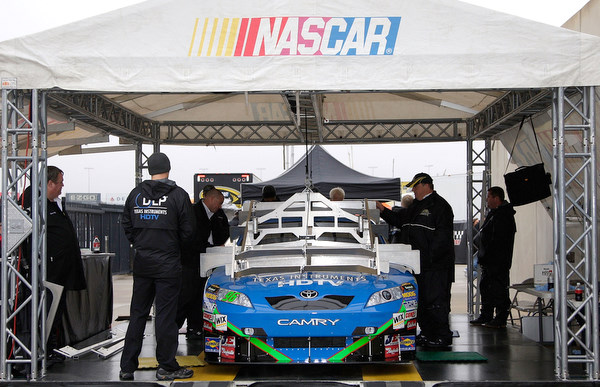
Is this really a Toyota? Or a Ford with the wrong decals? Where are the real NASCAR race cars today? (Photo: Getty Images for NASCAR)
By Mike Mulhern
mikemulhern.net
MARTINSVILLE, Va.
Hey, are you a Ford fan?
Are you a Chevy fan?
Are you a Dodge fan?
Remember those relics from the past?
They're probably being stuffed for exhibit in NASCAR's new Hall of Fame.
Shoot, what do car makes mean any more?
Little more than decals on the nose and tail.
Front grill identification? Give me a break.
And that's stock car racing?
Remember the good ol' days in NASCAR, when being a Ford fan really meant something, when being a Chevy fan was part of your sports DNA, and when Dodge fans were some of the most fervent in all of sports.
Remember all those torts and retorts:
'Friends don't let friends drive Fords.'
'Ford – First On Race Day.'
'Ford – Found on Road Dead.'
'MoPar - Mainly Obsolete Parts and Rust'
It may be hard to recall when when car-makes really were an important part of the fabric of this sport – up in the grandstands.
But this sport has really lost something important over the past several years, with these homogenized race cars NASCAR has been putting out on the track.
The hemi, the SuperBird -- er, the Plymouth Road Runner Superbird – and the similarly high-winged Dodge Charger Daytona, and the Ford Torino Talladega, the Mercury Cyclone….then Bill Elliott's fastback Thunderbird – and why it took so long for everyone to figure out it was 'aerodynamics' that made him quick enough to come from two laps down under green at Talladega is beyond me. And Terry Laise's ingenious 1987 Chevy retort – Dale Earnhardt's three-quarter-sized greenhouse Monte Carlo.
Hey, remember the Monte Carlo….and Bobby Allison's version, the Coke Machine.

Okay, okay, so sometimes Detroit gets a little carried away......1970 NASCAR champion Bobby Isaac here in a Harry Hyde winged Dodge (Photo:NASCAR)
What the heck is Chevrolet promoting in NASCAR today? The Impala? Well, it is a little better today than that old moose of a model that looked as out of place as that infamous Dodge Magnum.
What is Ford promoting in NASCAR? A family Fusion, off-spring from that not-quite-so-racy family Taurus.
What is Toyota promoting? Heck, they're upfront about NASCAR – they're trying to sell Tundra trucks, not Camrys, like they ostensibly race on Sundays. What the heck is that all about?
And if you can tell me what Dodge is racing, or what Dodge has out on the street…..is it the Charger or the Challenger or what? Talk about identity crisis.
If you can find any real difference between a 2009 NASCAR Ford and a 2009 NASCAR Chevy and a 2009 NASCAR Dodge and a 2009 NASCAR Toyota, I'll eat Richard Petty's cowboy hat.
Take the decals off and they're all the same, except for what's under the hood, and there's really not all that much different there either, to be honest.
And that makes for better racing?
Let's consider one number: 4.5. That's the TV rating last Sunday's Bristol race earned on Fox (Hey, David Hill, think it's time to revamp your lineup of announcers, maybe?)
If it ain't broke, don't fix it?
Well, judging from slumping TV ratings the past two years, and not-so-great attendance at many races (Atlanta was a joke), something is broke, and it's time to fix it.
There were 160,000 fans in those stands, and traffic was backed up in every direction for three hours after the race.
Yes, the racing was less than thrilling. (Hey, promoter Jeff Byrd, I'm sorry, did too good a job with that smooth new asphalt. How about a speed bump down in turn one, like at Las Vegas, to give these guys a challenge?) But the stands were packed.
This sport of stock car racing is alive and well…even if some of this sport's marketers (Is Sprint even in the sport any more? Maybe it's time to make another pitch to R. J. Reynolds or somebody who really knows how to sell something.) sometimes look like they're just throwing tomatoes at the side of the barn to paint a billboard.
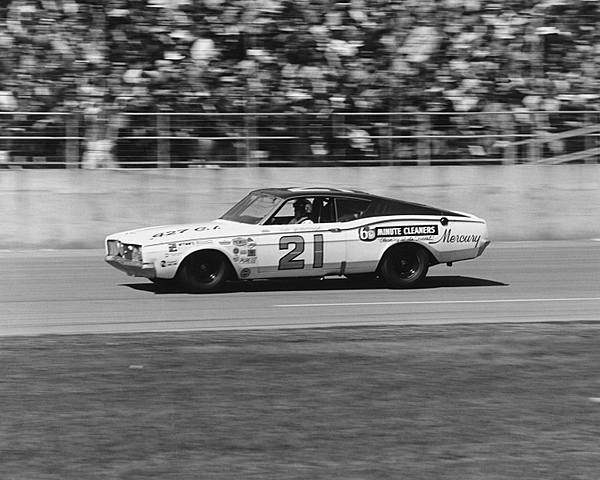
Hey, Cale: lost your rear spoiler? Nope. Odd as it may seem, there was a day when NASCAR drivers didn't even use rear spoilers (Photo: NASCAR)
And don't even get me started on how screwed up the Saturday Nationwide car-marketing game is: Why that series is not Camaros versus Mustangs versus Dodge (and let Toyota figure out a way to get Kyle Busch in something sporty too) is beyond me. That's such an obvious marketing campaign: Camaro SS vs Ford Mustang GT vs Dodge Challenger R/T….
If Detroit wants to use NASCAR to help sell cars, put some cars out there that people can relate to, put some technology out there that people can relate to.
NASCAR wants Detroit manufacturers to buy TV ads. Well, give Detroit something to put on the tube.
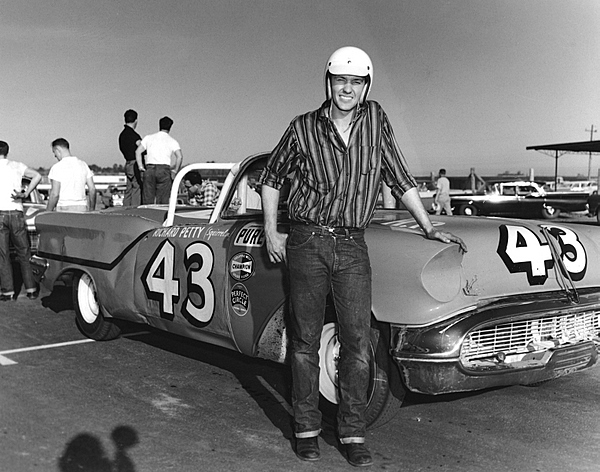
The King in a convertible, circa 1959....(does that really say 'Squirrel' on the door? Well, promoter Bruton Smith says it may be time for NASCAR to take some of these current cars, cut the tops off and make them into convertibles, and that would pack the stands. (Photo:Racing One/Getty Images)
This 'common template' body concept – which I deplored when NASCAR first began pushing it – is one of the worst things NASCAR executives have ever done to this sport.
And Detroit executives deserve equal blame for going along with that game.
Herb Fishel, the long-time Chevy racing boss, was right – the common template car is a dumb idea. Fishel was the last holdout in NASCAR's arm-twisting rush to make things easier on its inspectors and to stop the bickering. But whoever was boss at GM and accepted this boondoggle ought to be fired.
Why common templates?
First, to make inspections easier for NASCAR officials. Excuse me, but get sharper officials. (And NASCAR indeed today has the best corps of inspectors it has ever had, may Bill Gazaway rest easy.)
Second, to make things easier for Detroit officials, who thus don't have to worry about trying to be innovative. If everybody has the same body templates, 'hey, turn off the wind tunnel, unplug the computer, and let's all go have a Miller Lite and shoot the bull about the basketball playoffs.'
The common template concept is a lazy man's excuse for racing.

RP, dude: that's dirt, not asphalt, you're on. Bobby Allison chasing Richard Petty through the esses at Riverside in 1984: Buick chasing Pontiac. (Photo: NASCAR)
In these days of exotic, high-dollar computerized racing simulation programs, we can let Detroit be Detroit and start building real race cars again. And NASCAR's big and spiffy R&D center should certainly be able to keep on top of the aerodynamics of it all.
Remember when some cars, say Fords, would be faster into the corners than others, say Chevys, but then Chevys would be faster off the corners.
Gee, what a novel idea – that if different makes have different aerodynamic characteristics, then drivers might actually be able to pass somewhere….and then get passed back.
NASCAR and Detroit have together allowed this sport to become so plain vanilla, it's sickening, and the bosses need to sit back and reflect on that.
The best crew chiefs and mechanics in all of motorsports (sorry, F1) are right here in this garage. But NASCAR and Detroit have them working in handcuffs.
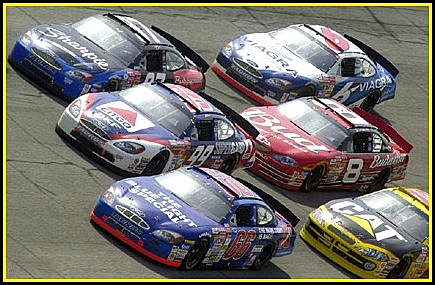
The roof-rails, used here at Talladega in 2001, seems to work well aerodynamically (Photo: Mark Martin)
NASCAR has done some good things over the years, some great things, some downright brilliant things -- the pit road speed limit after Mike Rich's death, the no-racing-back-to-the-yellow rule (though much too long in coming), and oh-so-many safety innovations, in particular soft walls.
But the common template (and that even-more-rigorously inspected car-of-tomorrow) is one NASCAR idea whose time has long since come and gone.
Just look at TV ratings and you can see somebody in Daytona – and Detroit – needs to do something.
When Bristol ratings are off nearly 20 percent, despite a sellout, something is wrong.
Daytona's rain, well, that didn't get things off to a rousing start, to be sure. But another California boring parade race (210 mph into the first turn? Give me a break.) and a terrible race at Atlanta – both in front of embarrassingly paltry crowds – should tell somebody something.
Bring back Detroit.
Let Detroit be Detroit.
Give us real race cars, not these shams, with those funny noses that are so fragile that crew chiefs put bumpstops in to keep them from breaking (now that's an entirely silly, yet expensive, engineering project from the word go.)

Racing the way it used to be: Daytona 1959 (Photo: Racing One/Getty Images)
The bottom line here:
Give Ford fans something to argue about. Give Chevy fans something to gripe about. Give Dodge fans something to raise hell about.
And don't try to tell me Toyota can't market feisty Kyle Busch on its tee-shirts and in its TV ads.
So one week one make has an edge….then change the rules. Put some fire back in this game. Put some emotion back in the stands.
Remember when Richard Petty's jump from Dodge to Ford was akin to him joining the Communist Party?
Remember when Junior Johnson 'fired' Chevrolet after some 20 years and jumped to Ford, because some idiot sent a set of his trick cylinder heads over to Rick Hendrick's shop?
Remember when, after Dodge executives (for some inane reason) bowed out of the sport, Petty (then back in MoPar colors) was wooed over to the GM camp, and given a lavish marketing campaign, something like 'Richard Petty, apple pie and Chevrolet."
Remember when Junior Johnson brought Chevy back into the game, in a great – and almost overnight -- Charlotte promotion?
Detroit is spending millions, maybe hundreds of millions, in this NASCAR game. Is it getting its money's worth? Or are all those guys in the corner suites just sitting fat, dumb and happy?
It's time to start selling cars, it's time to start marketing cars – race cars and street cars. It's time to get NASCAR and Detroit back on the same page.
If somebody doesn't do something, and fast, 2009 may go down as The Year of the Ostrich.
If NASCAR and Detroit let its fans fade away, they may never get them back.

NASCAR has certainly come a long way since this first race June 19th, 1949 in Charlotte, where cars were indeed strictly stock...too far perhaps, some might say. (Photo:Racing One/Getty Images)
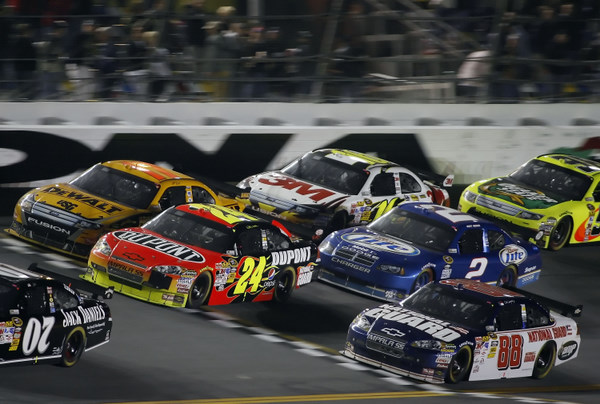
But then it's hard to argue with action like this: Daytona 2009 (Photo: Getty Images for NASCAR)
© 2010-2011 www.mikemulhern.net All rights reserved.
Web site by www.webdesigncarolinas.com







The cars are homogenized in
The cars are homogenized in large part because aerodynamic reality forced it. People talk about how different the cars were "back in the day." Well, take a closer look - Bobby Allison's 1972 Coke Machine Chevrolet aerodynamically was far more similar to Richard Petty and Bobby Isaac's Dodge Chargers than it was different, and even David Pearson's 1973 Mercuries bore aerodynamic similarity to the Charger. Before that the 1966 Dodge Charger was the most radical body in racing - and in 1968 Ford copied it with its Torinos and Mercury Cougars. NASCAR put the brakes on the wing cars because, let's be honest, they were too radical for the sport's own good.
As the technology arms race escalated in the 1980s the cars evolved alike - Bill Elliott's aerocoupe Thunderbirds were an aerodynamic knock-off of Bobby Allison's 1981 Pontiac Lemans but with rounder curves. The MN-12 body Thunderbirds of 1989-97 adapted the "long lean" aero profile of the mid-80s Monte Carlos - just as the GM-10 body cars came out looking more like Elliott's '85 Thunderbird.
And Robert Yates put it best years ago - the most aerodynamic shape there is is the raindrop, and that's what the cars became - raindrop bodies.
Heck, if you really want to reach, compare to the 1977 Olds Cutlass - that bodystyle was way ahead of its time.
What NASCAR has long been experiencing is what Indycars went through in the 1970s when the McLaren M-16 racecar debuted in 1971 - one basic aero shape worked better than all the others, so everyone had to ape that shape to keep up, to where by 1972 no one was running cars that looked all that different from the McLaren M-16.
All NASCAR did was put the reality of aerodynamic homogenization into the rulebook. That's not what is wrong here; what is wrong is the body style NASCAR has gone with now is totally wrong - a short nose, gapped airdam, top-heavy roofline, and the use of a wing instead of larger blade spoiler. Before that, what was wrong was NASCAR bastardizing downforce on the cars with its absurd 5 & 5 redux rule after 2003 - it should have gone to a larger rear spoiler and used the roof blade on all the tracks to slow the cars and make the racing better via a stronger draft; that package would have gotten drafting back onto the intermediate tracks.
Get back to the old car - long nose, flush airdam, chopped roofline - with the roof blade and a 7-inch rear spoiler.
Ah, yes, the days of those
Ah, yes, the days of those seven-inch spoilers...my how time flies.
So when you offer your technical analysis to NASCAR, what's the response?
I did an interview with Jim
I did an interview with Jim Hunter and others at NHIS in 2007 after the Mod Tour race where Tony Stewart got slammed to the backstretch dirt and the race ended under yellow and I pointed out how much better the racing was with those high downforce high spoilered restrictor plated cars, yet they seemed too stuck in their ways to listen even though Hunter was waxing poetic about how exciting the Modifieds race.
Nice photos, BTW, but it needs to be pointed out that as the cars got more unstable NASCAR increased spoiler size - in 1978 spoiler size increased by over an inch, and during Speedweeks 1981 spoilers were increased twice. If you can, put up a photo or two of the cars with the roof blade from Daytona and Talladega - that package was stable as anything and the racing was incredibly good.
Thanks.
As a longtime NASCAR fan, I
As a longtime NASCAR fan, I cannot understand the many comments longing to return to the car as it was just before the COT. The last few years of that car, I can recall race after race where a second place car would make up a lot of distance on the leader only to stagnate and be unable to pass him when he got to his rear bumper. The COT has problems, but it is better in that regard than the cars it replaced.
I can remember thinking in the last years before the COT, "Why can't they just use templates that force the racers to use the bodies of the 1970's cars again?" I thought the racing was great back then.
NASCAR made a mistake when trying to grow the attendance and interest in the sport. There were many people out there that weren't fans just because they hadn't been exposed to the thrill of NASCAR racing. They were diehard fans at heart, but just didn't know of their own desires. NASCAR's target should have been reaching those people. Instead, they tried to appeal to everyone and even changed their product to do that. Many of these new fans became temporarily interested, but it faded after a few years and they went on to something else. Some of the races years ago were won by a several lap lead. The fans still loved NASCAR racing. Try that with many of today's fans.
What we have today is racing that doesn't satisfy the diehard fans. The fans that are there just for the glitz, wrecks, and noise are starting to get bored and move on. NASCAR is beginning to look like it is failing because of that. NASCAR would have been better off never to have lured them in the first place.
Yes, the cars are all the
Yes, the cars are all the same. It would indeed be nice if they could race "real" cars, but the problem with that is Detroit doesn't even manufacture "real" cars. Yeah, NASCAR could change from carburetors to fuel injection. But one of the main differences is almost nothing out of Detroit is real wheel drive anymore. I 'spect it would be a pretty big change for the teams to build and race front wheel drive cars.
Oh, and while I think Richard Petty is the greatest thing since sliced bread, I've never quite forgiven him for 1969.
Nice piece, Mike. Even
Nice piece, Mike. Even before the COT was developed, they were trying to make all of the cars "equal". Whenever someone gained an "advantage" - new body, new nose, new engine, etc. - NASCAR stepped in to do something to negate it. Each decade since the 70's the cars took one step closer to the COT until NASCAR finally had them all looking the same, which was their goal. Now, IROC is a novel racing idea, and NASCAR cars are becoming just that, only with sponsor decals. The only problem with doing this is that if everybody is driving the same car, what's the point in any of the manufacturer's promoting THEIR car, or THEIR driver. Many of the traditional fans gave up on the NASCAR manufacturer alliegiance when Toyota entered the mix. I was against them being in at first, but I don't really care now. Since all the cars are the same, it really does not matter if you have a Chevy, Toyota, or Hyundai sticker on it. As STP43 fan said above, the cars can't have their own character if everyone is seeking one basic aerodynamic shape. And now, NASCAR has dictated that shape. Now, what can be changed to give each manufacturer back its own identity? Well, for starters, the cars have to be shaped somewhat like the actual cars, with the noses especially. Will that happen? Not likely. NASCAR likes their mandated equality, and if possible, would have 43 cars side-by-side crossing the finish line at the end of each race. They are also bringing in lots of money with this COT, in that each team has to buy many of the pieces directly from NASCAR. That's the big part of the COT equation nobody has written about. Since there is no real identity of any of the cars, why do Chevy, Ford, and Dodge need to remain in NASCAR? Sure the cars have their names on them, but they aren't really theirs. Most of the fans that developed alliegiances to a manufacturer at the track have since had no reason to keep it. Their marketing people say that their presence is still vital to them selling cars. I don't think that's the case. Thus, if I'm a Big 3 CEO, why pour money into NASCAR when it probably is not selling cars anymore, and the race cars don't look like anything I manufacture. The old slogan "wins on Sunday equal sells on Monday" no longer applies. The solution? As you said, Mike, something other than what is on the track now.
Addendum, from stp43, comes
Addendum, from stp43, comes this explanation of the recent evolution of NASCAR stockers:
"Following the much-criticized 1997 Daytona 500, NASCAR first tested roof-blades at Daytona in April 1997, with two Roush cars, Sterling Marlin in Morgan-McClure's Chevy, and Bobby Labonte in the Joe Gibbs' Pontiac. The package was enormously effective in producing passing, but NASCAR decided not to use it out of fear of having too much four-wide racing.
"But in 2000, after the artistic disasters of both Daytona races, NASCAR revived the roof blade and debuted it at the 2000 Winston 500, in which the late Dale Earnhardt Sr. made his dramatic charge from 16th to win in the last two laps, punting leader John Andretti off turn four. The race had 21 leaders, 49 official lead changes, and only three yellows.
"NASCAR tested a roof-blade with Steve Park at Charlotte in January 2001, and reportedly Ricky Rudd also tested a roof-blade at Atlanta that same month. Park said after the test the car "had an imbalance;" curiously no elaboration was given. Park also said the car could be run wide-open. I know of no other testing of the roof-blade package outside of the plate tracks. And it seems the only testing done was solo runs; no testing in traffic, to my knowledge, though at the time there was some speculation that NASCAR would begin integrating the package onto more tracks.
"The next plate race was the 2001 Daytona 500….14 leaders, 49 lead changes, only three yellows -- but the last one came when Robby Gordon slammed Ward Burton into traffic and Tony Stewart tumbled over 20 crashing cars. There is, alas, no need to elaborate on what happened on the final lap.
"The next plate race was at Talladega that April, with 26 leaders, 37 lead changes, and the late Bobby Hamilton stormed from mid-pack in the final seven laps to steal the win from Tony Stewart on the final lap. It was Andy Petree's debut win as a car owner. The race ran caution-free.
"At Daytona that July, there were nine leaders, 14 lead changes, and, to everyone's surprise, Dale Earnhardt Jr. led 116 laps -- where before no one had reached 60 laps-led with the roof package -- with almost no challenge all night and won handily. The fact he led so much (and blew past ten cars on a late restart) led Johnny Benson Jr. and Jimmy Spencer to publicly question the legality of Junior's car.
"At Talladega that fall there were 13 leaders, 32 lead changes, and Michael Waltrip led 53 laps (amid rumors DEI was already scouring the garage area for a driver to replace him in 2002) before his engine blew. Junior fought it out with Bobby Hamilton all day; he ultimately led 67 laps, lost the lead in a ferocious final ten laps to the Joe Gibbs Pontiacs, then stormed to the win as Bobby Labonte chopped off Hamilton and got hooked by Hamilton off turn two and slid into the field. Labonte flipped over and got hit by Kevin Lepage, Junior won the race.
"Afterward Sterling Marlin and I think at least one other driver stormed into the NASCAR hauler demanding removal of the roof package.
"NASCAR responded by calling a meeting with drivers and crew chiefs at NASCAR's new shop in Charlotte, this following the Rockingham race. There NASCAR said it would drop the roof-blade package.
"But after falling out of the 2003 Talladega 500, Sterling Marlin publicly said NASCAR needed to bring back the roof-blade package to make passing easier. In 2003 NASCAR increased spoiler size from six inches to almost seven for the plate tracks.
"NASCAR did bring back the roof-blade package for the Busch/Nationwide series for their plate races, this after Dale Junior led wire to wire in Daytona's Winn Dixie 250 in July 2003.
"A few of the Busch/Nationwide roof-blade races:
"Daytona February 2004 -- eight leaders, 16 official lead changes, Junior got into a fierce side-by-side duel with Johnny Sauter and Robby Gordon in the final ten laps before using a pack of lapped cars to break away enough to win.
"Talladega 2004 -- 11 leaders, 22 lead changes, Robby Gordon led the most laps in his own Chevrolet, Junior pushed teammate Martin Truex Jr. to his first BGN win.
"Daytona July 2004 -- nine leaders, 15 lead changes, and the finish of the decade: Robby Gordon cut a tire on the restart with ten to go and lost the lead and a lap. Mike Wallace in Fred Biagi's Ford went for the lead a lap later but got drafted back as Junior took over. Michael Waltrip and Jason Leffler hooked up from 25th and stormed to the lead with three to go. But with two to go Leffler went for it, and the two drag-raced for over a lap until on the final lap Leffler hammered Waltrip into the inside wall off turn two. Junior stormed up to Leffler and shot high, but Leffler swerved Junior hard into the wall, and Mike Wallace shot the gap to the win…the biggest upset in NASCAR until David Gilliland's less spectacular Kentucky win two years later.
"2006 February Daytona -- nine leaders, 17 lead changes. On the final restart with five to go Dale Junior jumped outside of Tony Stewart for the lead, then Michael Waltrip stormed three-abreast up high, and the entire field raced three-abreast for three straight laps before Stewart fought off Junior and then gunned down Waltrip with two to go. It was Stewart's second straight February Daytona BGN win.
"2006 Talladega April -- nine leaders, 29 lead changes. Tony Stewart stood on his roof at the start-finish line after leading 25 laps. Truex took the win again as the Rick Hendrick and RCR Chevys spent the last 18 laps fighting each other instead of going after the DEI car.
"2007 Talladega April -- 20 leaders, 37 lead changes. Casey Mears led 52 laps before Tony Stewart stormed into the lead with two to go. But then Bobby Labonte snookered Stewart on the final lap for the win.
"2009 Daytona February -- 10 leaders, 18 lead changes. Tony Stewart got into several running side-draft battles for the lead all day. Kyle Busch tried to punt Stewart sideways on the last lap and wound up losing second as a result. The win was Stewart's debut win in a Rick Hendrick car.
"So basically that roof package works like nothing else ever has.
"NASCAR could have kept that package, and it would have solved a lot of the problems of competition they thought they were solving with the car-of-tomorrow."
Post new comment